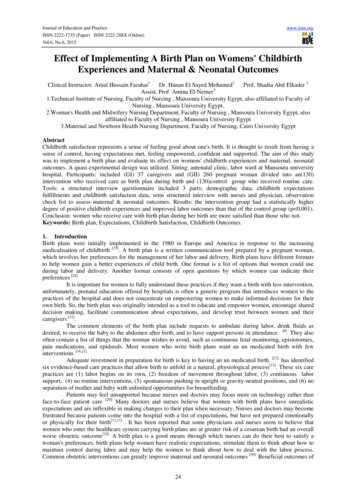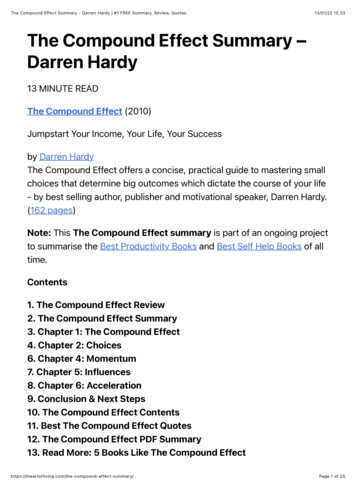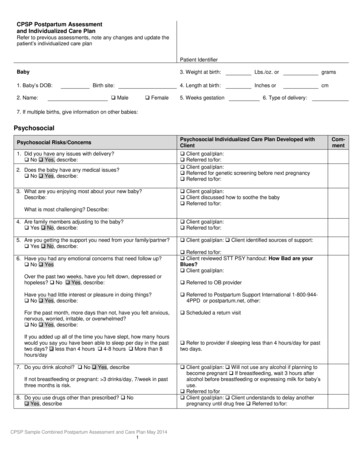
Transcription
Journal of Education and PracticeISSN 2222-1735 (Paper) ISSN 2222-288X (Online)Vol.6, No.6, 2015www.iiste.orgEffect of Implementing A Birth Plan on Womens' ChildbirthExperiences and Maternal & Neonatal OutcomesClinical Instructor. Amal Hussain Farahat1Dr. Hanan El Sayed Mohamed2Prof. Shadia Abd Elkader 23Assist. Prof Amina El-Nemer1.Technical Institute of Nursing, Faculty of Nursing , Mansoura University Egypt, also affiliated to Faculty ofNursing , Mansoura University Egypt.2.Woman's Health and Midwifery Nursing Department, Faculty of Nursing , Mansoura University Egypt, alsoaffiliated to Faculty of Nursing , Mansoura University Egypt3.Maternal and Newborn Health Nursing Department, Faculty of Nursing, Cairo University EgyptAbstractChildbirth satisfaction represents a sense of feeling good about one's birth. It is thought to result from having asense of control, having expectations met, feeling empowered, confident and supported. The aim of this studywas to implement a birth plan and evaluate its effect on womens' childbirth experiences and maternal, neonataloutcomes. A quasi experimental design was utilized. Sitting: antenatal clinic, labor ward at Mansoura universityhospital. Participants: included (GI) 37 caregivers and (GII) 260 pregnant woman divided into an(130)intervention who received care as birth plan during birth and (130)control group who received routine care.Tools: a structured interview questionnaire included 3 parts; demographic data, childbirth expectationsfulfillments and childbirth satisfaction data, semi structured interview with nurses and physician, observationcheck list to assess maternal & neonatal outcomes. Results: the intervention group had a statistically higherdegree of positive childbirth experiences and improved labor outcomes than that of the control group (p 0,001).Conclusion: women who receive care with birth plan during her birth are more satisfied than those who not.Keywords: Birth plan, Expectations, Childbirth Satisfaction, Childbirth Outcomes.1. IntroductionBirth plans were initially implemented in the 1980 in Europe and America in response to the increasingmedicalisation of childbirth [35]. A birth plan is a written communication tool prepared by a pregnant woman,which involves her preferences for the management of her labor and delivery. Birth plans have different formatsto help women gain a better experiences of child birth. One format is a list of options that women could useduring labor and delivery. Another format consists of open questions by which women can indicate theirpreferences [24].It is important for women to fully understand these practices if they want a birth with less intervention,unfortunately, prenatal education offered by hospitals is often a generic program that introduces women to thepractices of the hospital and does not concentrate on empowering women to make informed decisions for theirown birth. So, the birth plan was originally intended as a tool to educate and empower women, encourage shareddecision making, facilitate communication about expectations, and develop trust between women and theircaregivers [32].The common elements of the birth plan include requests to ambulate during labor, drink fluids asdesired, to receive the baby to the abdomen after birth, and to have support persons in attendance [6]. They alsooften contain a list of things that the woman wishes to avoid, such as continuous fetal monitoring, episiotomies,pain medications, and epidurals. Most women who write birth plans want an un medicated birth with fewinterventions [14,21].Adequate investment in preparation for birth is key to having an un medicated birth. [27]. has identifiedsix evidence-based care practices that allow birth to unfold in a natural, physiological process[12]. These six carepractices are (1) labor begins on its own, (2) freedom of movement throughout labor, (3) continuous laborsupport, (4) no routine interventions, (5) spontaneous pushing in upright or gravity-neutral positions, and (6) noseparation of mother and baby with unlimited opportunities for breastfeeding.Patients may feel unsupported because nurses and doctors may focus more on technology rather thanface-to-face patient care [20]. Many doctors and nurses believe that women with birth plans have unrealisticexpectations and are inflexible in making changes to their plan when necessary, Nurses and doctors may becomefrustrated because patients come into the hospital with a list of expectations, but have not prepared emotionallyor physically for their birth[12,21] . It has been reported that some physicians and nurses seem to believe thatwomen who enter the healthcare system carrying birth plans are at greater risk of a cesarean birth had an overallworse obstetric outcome[24]. A birth plan is a good means through which nurses can do their best to satisfy awoman's preferences, birth plans help women have realistic expectations, stimulate them to think about how tomaintain control during labor and may help the women to think about how to deal with the labor process.Common obstetric interventions can greatly improve maternal and neonatal outcomes [39]. Beneficial outcomes of24
Journal of Education and PracticeISSN 2222-1735 (Paper) ISSN 2222-288X (Online)Vol.6, No.6, 2015www.iiste.orga positive childbirth experience include self-esteem, efficient and enhanced maternal attachment and compliance,a good outcome should be that every woman should be satisfied with the care and support she received duringpregnancy, delivery and postpartum periods and to feel that she and her baby have been the center of care[40].Nurses and other caregivers have a crucial task in childbirth experience, women who received care frommidwives had higher self-esteem and self-efficacy and empowerment they were also able to achieve a sense ofmastery during pregnancy, labor, and the child rearing period, which are valuable to women's birth experience[20].Nurses have an important role in providing information and increasing understanding as well as keepingcommunication going between a woman and her provider[25].2.Significant of the studySupporting women’s preferences during labor has been shown to increase satisfaction with birth [12]. The creationof a birth plan helped to ameliorate a disabling fear of childbirth[23,24]. Women stated that it was helpful to thinkabout and write down their preferences, and know that their needs would be attended to. Medicalisation ofchildbirth in developing countries has not always translated into satisfactory childbirth experiences amongwomen [25]. To date, discussion, educating about birth plan, and implementing it are not documented, however itcan improve quality of care and increase communication between the pregnant women and health care providers,the fulfillment of women's expectations and feeling of control from antenatal to the childbirth period have notinvestigated [24]. No investigation about birth plan have been conducted in developing countries [38]. In addition,while midwives have taken a lead role in promoting birth plans in other countries. It was interesting to knowhow nurses can take the lead role in implementing the birth plans for primiparae. Introducing birth plan in theregime of care during antenatal care is novel in Egypt.3.Aim of the studyThe present study aims to implement a birth plan and evaluate its effect on womens' childbirth experiences,maternal and neonatal outcomes4.Research Methodology4.1 DesignQuasi-experimental design was utilized .4.2 SettingThe present study was carried out at antenatal clinic and labor unit in Obstetric & Gynecology Department atMansoura University Hospital, during the period from the end of February 2013 to the end of October 2013.4.3 SubjectsThe subjects of the study included two groups: Group(I): Included all healthy care providers obstetricians &nurses (n 37) who were working in labor & delivery unit at hot delivery days during period of collecting data.Group (II): included 260 pregnant women selected by simple random sample technique and divided equallyinto two groups the intervention group which consisted of 130 pregnant women odd numbers takes birth plan I tofill it and received care during labor as planned, while the control group which consisted of 130 pregnant womeneven numbers received routine care during labor, the pregnant women were allocated to the study according tothe following criteria: Primiparous women; gestational age from 36 to 42 weeks; age 18 years or more; normalpregnancy; read & write; women welling to participate.4.4 Birth plan:A birth plan (I) prepared based on standard birth work sheet for Jennifer2008. It translated & introduced topregnant women in intervention group to choose and write her birth plan in antenatal clinic, it consisted ofwomen preferences such as (clothes, birth attendances, mode of delivery, method for starting labor, supportperson and pain relief measures), care during 1st stage such as (routine care, fetal monitoring, food, hydration,bathing and movement), care during 2nd stage such as (type of pushing, position of delivery and perinealcondition) care after delivery such as(suction, other baby care, first one carrying and dressing the baby, firstfeeding and hospital discharge). Birth plan II prepared based on evidence based practices during childbirth. Itreviewed by supervisors and implemented by researcher on the intervention group, it consisted of completehistory taking, Physical examination, supportive care measures for each stage of labor were applied for women,the partograph was used for every participant to record data about: fetal condition, labor progress and maternalcondition. select support person, maintain early attachment between women and baby, health education aboutbreast feeding ,family planning, vaccination and postpartum visits.4.5 Tools of Data CollectionThree tools were used in this study (1) Structured Interview Schedule. It was designed by the researcher, andreviewed by the supervisors. It aims to document the effect of implementing birth plan on womens' experiencesduring childbirth. It consisted of 3 parts: Part 1 ''Socio demographic data'' as: age, level of education, phonenumber, gestational age, occupation and monthly income. Part 2 ''Childbirth expectations fulfillment sheet'' it is25
Journal of Education and PracticeISSN 2222-1735 (Paper) ISSN 2222-288X (Online)Vol.6, No.6, 2015www.iiste.orga check list to assess the fulfillment of women's expectations (birth plan I options) during child birth process.Part 3 ''Child birth satisfaction questionnaire'' it records the measured degree of satisfaction womens' regardingchildbirth experiences based on validated Mackey childbirth satisfaction rating scale. It consisted of 40 questionsfrom 1 to 34 the responses will be comprises of Five point ranged from (1) very dissatisfied,(2) dissatisfied, (3)neither satisfied nor dissatisfied,(4) satisfied, (5) very satisfied. The total score 136 indicated satisfaction 136indicated dissatisfaction. Questions 35 & 36 were open ended for the woman to contribute her over allsatisfaction /dissatisfaction with her child birth experiences. The questions from 37 to 40 the responses will becomprises of four point ranged from (1) very negative,(2) somewhat negative,(3) somewhat positive,(4) verypositive. The total score 12 indicated positive experiences 12 indicated negative experiences. (2) SemiStructured Interview with nurses and physician to document feasibility & barriers of implementing a birth planin maternity care which includes three open ended questions (factors facilitate implementing of birth plan,barrier for implementing birth plan, and their point of views regarding how birth plan can be a routine careduring birth).(3) Observation Sheet :this check list was used to assess maternal outcomes ( it included theduration of the stages of labor, mode of delivery, and measuring of pain level using Visual AnalogueScale(VAS), neonatal outcomes (it included baby weight, apgar score at 1st & 5th minute).Methods of Data CollectionThe researcher introduced herself to eligible women, and briefly explained the nature of the study, then writtenconsent was obtained from them, the interview took from 30 to 40 minutes with each woman in interventiongroup after admission to the antenatal clinic, the check list (birth plan I) was Prepared by researcher introducedto pregnant woman to choose and write her birth plan, explanation and discussion about (birth plan I) wasconducted with pregnant woman in the intervention group, during childbirth, birth plan was given to nurse andphysician to provide care for each woman according to her birth plan, the woman in control group receivedroutine care with out giving detailed information, each participant was allocated to the proper group according tothe care received, the physician and nurses were asked about feasibility & barriers of implementing a birth planin maternity care, then the maternal assessment was performed on pregnant women in the intervention groupused birth plan II. after that maternal and neonatal outcomes were observed and recorded to both groups a Afterdelivery and before discharge from the hospital. Finally, the researcher asked the women if she was satisfiedwith her labor and delivery used Mackey childbirth satisfaction rating scale. The patient's permission wasobtained to collect the remaining data by telephone during the 1st weeks of delivery.Ethical ConsiderationsPermission to carry out the study was obtained from the supervisor of Maternity and Gynecology of NursingDepartment. The director of Mansoura University Hospital. The head of Obstetrics and Gynecology department.The researcher introduced her self to all health care providers & parturient women and the aim of the study wasexplained prior their participation to obtain their acceptance & cooperation as well as their written consent.Statistical analysisThe statistical analysis of data was done by using SPSS program (statistical package for social science version10). The demographic data and clinical characteristics were summarized as the mean, SD for continuousvariables, and as frequency counts (percentages) for categorical variables, Statistical significant differencebetween intervention and control groups was tested by student t-test and Chi square test. Spearman correlationCo-efficiency test was used to test association between variables, P is used at 0.05 level of significance, atconfidence interval 95%.Comparison of MEAN & SD between both groups regarding satisfaction, duration oflabor and apgar score was tested by student t-test.Comparison regarding causes of satisfaction & dissatisfaction,mode of delivery and pain level was tested by Chi square test.5. ResultsTable 1 Shows that no significant difference of the general characteristics of women among the study group. Themean age of women in intervention group was (20.6 1.9) compare to (19.9 2.1) of control group. Regardingeducation, the highest percentage of intervention & control group had basic (secondary)education (80%&82%respectively) with no significance difference. Also the table shows more than one-half of women in the studygroup had 37-38 weeks of gestation (50.5%&55% respectively). Meanwhile, the majority of women in bothintervention and control group were housewives (77%&92% respectively), the difference was significance .Table 2 reveals women in the intervention group had higher mean (142.7 11.4) of satisfaction thanthose in the control group (84.6 4.6) similarly, they had higher mean (1.8 0.3) of positive experience of labor& delivery than those in the control group (1.3 0.4). There were highly statistical significance differenceamong the groups p 0.001.Table 3 reveals that there were statistically significant difference between control & intervention26
Journal of Education and PracticeISSN 2222-1735 (Paper) ISSN 2222-288X (Online)Vol.6, No.6, 2015www.iiste.orggroups and the duration of the second stage of labor with mean of (23.6 4.8) in intervention group & (27.4 9.7) in the control group).Table 4 shows that there were highly statistical significance difference among the intervention &control group regarding the two mode of delivery and pain levelTable 5 shows that there were highly statistical significance difference among the intervention &control group regarding the two apgar scores in 1st & 5th minute ( p 0.001). while no statistical significancedifference among the groups regarding the baby weight.Figure 1 shows that the highest cause of satisfaction was regards to the care provided 30% followed bygood communication 26% support person 20% & the availability of the safe delivery.Figure2 shows that the highest cause of dissatisfaction was regarding to episiotomy 29% followed by23% repeated vaginal examination, no privacy 23% & Un safe delivery 20% there were highly significancedifference among the groups p 0.001Table (1): The percentage, mean score and standard deviation of the study groups according to theirgeneral characteristics.General CharacteristicsControl(N 130)Intervention(N 130) χ 2PvalueNo%No%Age( Mean SD)19.9 2.120.6 1.91.80.06Education- Basic education11882104800. 10.7- University24182620Weeks of gestation37-3872556650.50.60.739-4050385643 418686Occupation- Housewife1209210077 11.70.0006*- working107.53023Table (2): Number & Percentages of the study groups according to satisfaction after delivery.PWoman satisfaction scoreControl(N 130)Intervention(N 130)χ2No%No%- Satisfied 1363224.510278.547.9 0.001*- Dissatisfied 13698752821.5Total (MEAN SD )84.6 4.6142.7 11.438.05 0.001*- Positive experience 123627.511487.595.3 0.001*- Negative experience 1294721612Total (MEAN SD)1.3 0.41.8 0.38.6 0.001*Table (3): Mean score and standard deviation of duration of labor among the study groups.DurationControl(N 130)Intervention(N 130) χ 21st stage- MEAN SD2nd stage-MEAN SD3rd stage-MEAN SD756 116.8755.08 130.527.4 9.723.6 4.87.7 2.6277.07 3.04P0.040.92.790.006*1.30.1
Journal of Education and PracticeISSN 2222-1735 (Paper) ISSN 2222-288X (Online)Vol.6, No.6, 2015www.iiste.orgTable (4): ): Number & Percentages of distribution of the study groups according to mode of delivery andpain level.ItemsControl(N 130)Intervention(N 130)χ2PNo%No%Mode of deliveryNormal delivery21.5161213.60.001*- Normal delivery with episiotomy1048010077- C.S.24181410.5Pain level- Mild0022.2 0.001*- Moderate50388867.5- Severe8061.54232Table (5): Mean score and standard deviation of apgar score and baby weight among the study groups.Intervention(N 130)χ2PApgar scoreControl(N 130)MEAN SD1st min. Apgare5th min. ApgareBaby Weight5.5 1.357.33 1.382.9 0.657.09 0.559.12 0.52.9 0.378.79.70.3 0.001* 0.001*0.7Figure (1): Number & Percent distribution of the study groups according to causes of satisfaction.28
Journal of Education and PracticeISSN 2222-1735 (Paper) ISSN 2222-288X (Online)Vol.6, No.6, 2015www.iiste.orgFigure (2): Number & Percent distribution of the study groups according to causes of dissatisfaction.Safe delivery: Means baby is healthy and no need for incubator.Un safe delivery: Means baby need for incubator.6. DiscussionRegarding to birth plan and women satisfaction & experiences after birth there were astatistically significantassociation between satisfaction and experiences of labor & delivery, Women in the intervention group hadhigher mean of satisfaction and positive experiences of labor and delivery than those in the control group. Thesefindings in agreement with Ip et al., [31] who found that child birth preparation classes, birth planning, midwifepreparation, and medical & social support are some of the activities that could be organized adhoc to thewomen's needs and promote the best birth experiences. Simby [23], Kue [24], yam [38] reported that women whowrite birth plan has more childbirth satisfaction . These findings were in disagreement with Capitulo, Perez andLepsch [11] who reported that the birth plan is not necessary, instead, labor and birth units should provideevidence-based care and birth experience if the best care is available and standards are met, there should be noneed for birth plans.In relation to causes of satisfaction. The current study finding showed that the highest causes ofsatisfaction was regarding to care provided & good communication followed by support during birth. Thisfinding was in agreement with Lothian [26] who stated that all the components of a satisfying birth- a positiverelationship with the midwife, excellent labor support, high expectations for the experience, and being part ofdecision making-were present by the time the women went into labor.These were in a agreement with Owies [33] who stated that, the variable that are most frequentlyassociated with childbirth satisfaction are expectations, labor pain and experience of control, as well as supportin labor & birth, and reported the way in which women are helped to deal with pain, the extent to which they feelthat they are actually cared about, rather than care is some-thing that is done to them, will affect their sense ofcontrol and their satisfaction. A birth plan can be a medium to improve patient- provider communicationregarding a desired labor and birth experience Dedereq [13].Regarding to relation between birth plan and child birth outcomes among both study groups: Ourfinding in the same line with Hadar [22] who reported that, a birth plan reduce cesarean section rate is novel.Previous studies have either found no difference or did not address the issue of mode of delivery as an outcomeDeering, Zaret, McGaha, and Satin [14]. This results disagreement with Pennell et al., [32] who found an increasedrate (28.6%) of cesarean birth in women who prepared birth plans compared with the overall rate at theirinstitution.This results in agreement with Brown & Lumely [9] in cohort of 259 women found that those preparinga birth plan were less likely to undergo an operative vaginal delivery (9.6% VS 14.6%). And agreeing withdowell et al., [15], El-Nemer [16] who reported that there is good evidence that normal birth rate can be used asindicator of the quality of maternity care.The current study shows that, birth plan trained companionship utilized different measures to reliefsignificantly mother labor pain and also, significantly improve labor outcome and mother satisfaction regardinglabor experiences. These findings by El-Nemer [17]who reported that, the embodied knowledge of mothers(companion) as a first educator and a trustworthy source of information from a basic source of knowledge cansupport & help women during labour. Also in agreement with Escoott et al., [18]who stated that antenatalpreparation and classes include information about child birth process, options for medication based pain relief,29
Journal of Education and PracticeISSN 2222-1735 (Paper) ISSN 2222-288X (Online)Vol.6, No.6, 2015www.iiste.orgthe opportunity for women to develop coping strategies for managing pain and anxiety in labor, increasedparental knowledge so they can make decisions because they are having a proper knowledge and information.These findings of study in agreement with Vadivelu etal.,[37] & Mckinney etal., [30], who reported that the feelingof apprehension during labor, increase maternal catecholamine levels that lead to inhibition of uterinecontractility and prolonged labor. Also in accordance with new researches Ward & Hisley [36], Barrett & Stark [8],Anderson & Stone [5]showed that support by nurses during labor has a positive effect on maternal and fetaloutcomes.8. Conclusionthe findings of the present study are high lighted some of important features regarding the effect of birth plan onchildbirth experiences and maternal & neonatal outcomes such as Birth plan has a positive effect on mode ofdelivery (reduce C.S.), there was a significant decrease in the pain level and improve apgare score of newbornafter using birth plan, also there was a highly satisfaction level in the intervention group after using birth plan(p 0,001).9. RecommendationsBased on the results of the present study, the following can be recommended: Spreading awareness of healthcare providers of antenatal clinic, labor ward and encourage them to provide health instructions about the use ofbirth plan on increasing level of women's satisfaction and improve maternal & neonatal outcomes, policy makersdesigning standardized hospital birth plan to improve maternity care and evaluate & follow up theimplementation of the birth plan, spreading awareness about midwifery role on implementing birth plan, trainingstaff and select skilled birth attendance for implementing birth plan, further study is needed to investigate thebirth outcome after using birth plan.10. References1.Abdel-Aleem, H., Aboloyoun, E.M., Moftah, F.M., Ismail, S., Abdullah, S. A., Utilization of maternalcare in Upper Egypt. Assiut University . Journal of Community Medicine(1992); 10 (2): 133-143.2.Abdel-Maguid Ramzy: Maternal Mortality in Egypt .Obstetric & Gynecology Department, CairoUniversity. 2007; Issue17: reviewed from ramzy am @ hotmail.com.3.Abigail, T., Sarah, F :Review of Pain Control Methods after an Episiotomy. Pharmacy & Nursing StudentResearch and Evidence. Based Medicine., 2012; (11):1 p 21.4.American College of Obstetricians and Gynecologists(ACOG): Timing of umbilical cord clamping afterbirth. Committee opinion,number543. 2012; retrievedfromhttp:// www.acog.org/ ric20%practice/co543.pdf?dmc 1&ts 20130126t0931479458 on 2013.5.Anderson, B., Stone, S., Best Practices in Midwifery: Using the evidence to implement change. UnitedState of America. Springer publishing, LLC co, 2013; pp 44-47.6.Anderson, C. J., & Kilpatrick, C. Supporting patients’ birth plans: Theories, strategies & implications fornurses. Nursing for Women’s Health, 2012; 16(3), 210-218.7.Avery M.Supporting a physiologic approach to pregnancy and birth: a practical guide. Pearson, WileyBlackwell co, 2013; pp.83,96.113.8.Barrett, S., Strak, M. Factors associated with labor support behaviors of nurses. The Journal of PerinatalEducation 2010;19(1):12-18.9.Brown, S., & Lumley, J. Communication and decision- making in labour: Do birth plans make adifference? Health Expectations.1998; 1, 106-116.10.Bertucci, M.A., Boffo, M.A., Sccardi, MD. Assessing the perception of the childbirth experience inItalian women: A contribution to the adaptation of the childbirth perception questionnaire. Midwifery,(2011); doi:10.1016/j.midw.2011.02.009.11.Capitulo, K., Perez, P., & Lepsch, S. Birth plans: Are they really necessary?. writing for the proposition. writing for the con posi- tion [Second opinion]. MCN: The American Journal Of MaternalChild Nursing, 2005; 3 (5): 288-289.12.Carlton, T., Callister, L. C., & Stoneman, E. Decision making in laboring women: Ethical issues forperinatal nurses. Journal of Perinatal & Neonatal Nursing, 2005; 19(2):145-154.13.Declercq E. R., Sakala C., Corry M. P., Applebaum S. Listening to mothers II: Report of the secondnational U.S. survey of women's childbearing experiences. The Journal of Perinatal Education , 2006;16(4): 9-14. doi: 10.1624/105812407X24476914.Deering, S. H., Zaret, J., McGaha, K., & Satin, A. J. Patients presenting with birth plans: A case–controlstudy of delivery out- comes. The Journal of Reproductive Medicine,2007; 52(10): 884- 887.15.Dowell, M., Newbrun, M. Normal Birth as a Measure of the quality of care. Evidence on safety,30
Journal of Education and PracticeISSN 2222-1735 (Paper) ISSN 2222-288X (Online)Vol.6, No.6, 1.32.33.34.35.36.37.38.www.iiste.orgeffectiveness and women's experiences. NCT. Alexandra House; Oldham terrace London, 2010; W36NHfrom ncy-birth-and-postnatal-care/birth/normal-birthon 2013.EL-Nemer, A. Helping from the heart A feminist Ethnography of Egyptian Women’sChildbirthExperiences, Thesis submitted to school of health studies division of Midwifery and Woman’s Healthin partial fulfillment of doctorate degree in nursing science obst and Gyne, University ofBradford,UK, 2003El-Nemer, A., Downe, S., Small, N' she would help me from the heart': Ethnography of Egyptian womenin labor. Social Science & Medicine. 2006; 62,81-92.Escott, D., Slade, P., and Spiby, H. preparation for pain management during childbirth: the psychologicalaspects ofcoping strategy development inantenataleducation, clinical psychology review, 2009; 29(7):617-622.Fair, D, C. The relationship between prenatal control, expectations, experienced control, and satisfactionamong primiparous women. Midwifery, 2010; doi:10:1016/j.midw.2010.10.013.Fleming, S. E., Smart, D., & Eide, P. Grand multiparous women’s perceptions of birthing, nursing care,and childbirth technology. The Journal of Perinatal Education, 2011; 20(2): 108-117. doi: 10.1891/1058-1243.20.2.108.Grant, R., Sueda, A., & Kaneshiro, B. Expert opinion vs. pa- tient perception of obstetrical outcomes inlaboring women with birth plans. The Journal of Reproductive Medicine, 2010; 55(1-2): 31-35.Hadar, E., Raban, O., Gal, B., Yogev, Y., & Melamed, N. Obstetrical outcome in women with selfprepared birth plan. The Journal of Maternal-Fetal and Neonatal Medicine, 2012; 25(10): 2055-2057. doi:10.3109/ 14767058Helk, A., Spilling, H. S., & Smeby, N. A. Psychosocial support by midwives of women with a fear ofchildbirth: A study of 80 women. Nordic Journal of Nursing Research & Clinical Studies/Vard I Norden,2008; 28(2): 47-49.Kuo, S.C., Lin, K.C., Hsu, C.H. Evaluation of the effects of a birth plan on Taiwanese women's childbirthexperiences, control and expectations fulfillment: a randomized controlled trial. International Journal ofNursing Studies2010; 47, 8.Lothian, J. Birth plans: the good, the bad, and the future. Journal of Obstetric, Gynecologic, and NeonatalNurs
4.4 Birth plan: A birth plan (I) prepared based on standard birth work sheet for Jennifer2008. It translated & introduced to pregnant women in intervention group to choose and write her birth plan in antenatal clinic, it consisted of women preferences such as (clothes, birth attendances, mode of delivery, method for starting labor, support










